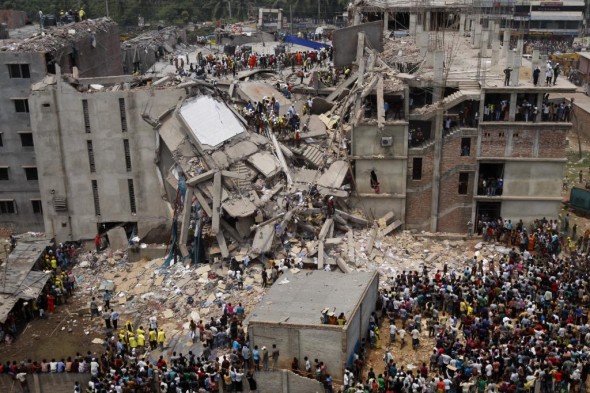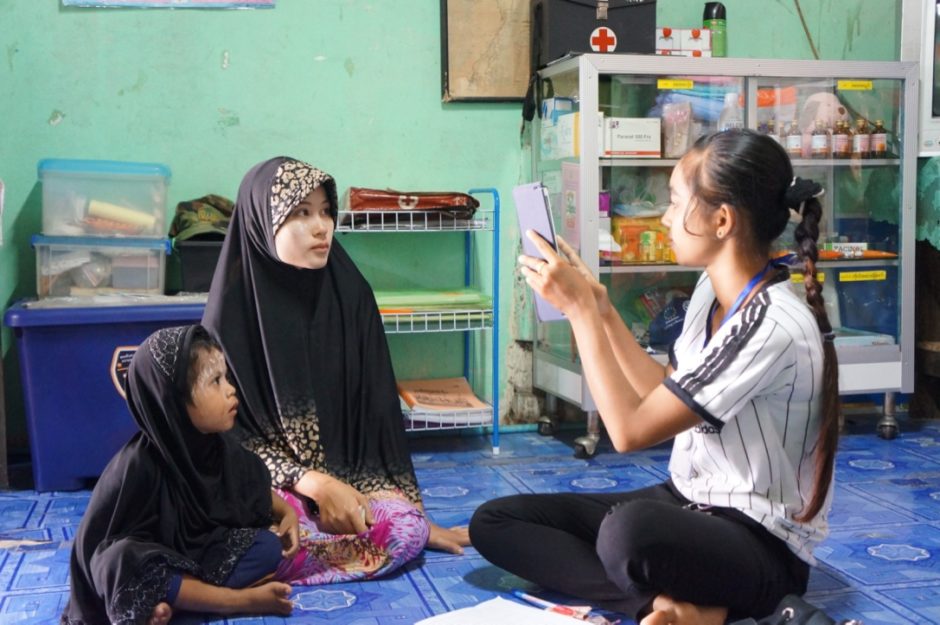The Guardian US/UK | September 10, 2013 | Original headline: Bangladesh factory collapse: can Gap and others pin down worker safety?

On April 24, 2013, the Rana Plaza factory building collapsed, killing more than 1,100 garment workers and injuring 2,500 more in Dhaka, Bangladesh. Photo credit: rijians via flickr/Creative Commons
Nearly five months after the collapse of the eight-story Rana Plaza building that killed more than 1,100 garment workers and injured 2,500 in Bangladesh, the reverberations continue to impact the apparel industry.
The incident – and it lessons about supply-chain vulnerabilities – has boosted efforts to improve worker and building safety.
“[Bangladesh] is an inflection point for monitoring and auditing supply chains,” said Kindley Walsh Lawlor, vice president for corporate social responsibility at Gap, speaking at the Social Capital Markets conference in San Francisco last week.
But companies remain divided on how best to do this in a country that’s one of the industry’s top suppliers.
Different approaches
Gap is part of an alliance of more than 15 companies – including Walmart, Kohl’s, Target and Macy’s – which has agreed to require factory inspections (and publicly release the results) in Bangladesh, develop common safety standards, provide loans to factory owners to improve safety, establish a worker hotline before the end of the year and establish “worker participation committees” selected by their peers.
The Alliance for Bangladesh Worker Safety has set a five-year timeline for the project.
Lawlor – who has focused on fire and building safety in Bangladesh since 2010, when a factory fire near Dhaka killed more than 25 people – says Gap is bringing in professional engineers to inspect supplier factories and also is following up with remediation.
“We’re seeing the suppliers through the process and making sure they make the changes,” she said.
But Gap’s approach has been controversial. The company and its partners have been criticized by labor rights groups for not including for a requirement to allow supplier workers – mostly women earning low wages – to organize unions.
Meanwhile, more than 70 other companies have signed a different accord, which does endorse the right of workers to organize as part of an overall strategy to improve factory safety in Bangladesh. H&M, Zara, Tommy Hilfiger and Calvin Klein were among the companies to sign the accord, which requires independent factory inspections and public release of the results. Unlike Gap’s initiative, this accord is legally binding.
Taking a systemic approach
Racheal Meiers, head of BSR‘s HERproject, a factory-worker education project in Bangladesh, India, China and a half dozen other countries, said the Bangladeshi government also must play its part in fixing the health and safety problems.
HERproject works with Gap, in addition to Marks and Spencer, HP and J.Crew.
“We have to take a systemic approach for progress to be made,” she said. “If Gap has a robust fire safety standard, there aren’t many people in the country who can do those international fire safety and building safety inspections.”
But many of the factory owners in Bangladesh also have high influence in the government, she said.
“Even if factory owners do make changes – such as the two years it took to raise worker wages by between $6 to $7 a month – the impacts on workers’ lives are limited within the workplace itself,” she said. “Once the slum landlords found out that the workers got a raise, they increased the rent.”
For that reason, Meiers says, HERProject focuses on increasing the wellbeing of workers by educating the mostly female workforce on menstruation, infectious diseases, maternal health and HIV/AIDS. It teaches women how to make more nutritious food choices and how to access improved health care.
Education sessions are designed for a workplace setting and present factory owners with the business case for a healthy workforce. “The business case is important,” Lawlor said.
Boosting the business case
Aside from working with HERproject, Gap also runs a life skills education and technical training program – called Personal Advancement & Career Enhancement (P.A.C.E.) – for female garment workers.
“It’s proven these women [who participate in P.A.C.E.] have longer tenure and are being promoted more often,” Lawlor said. “They are making more money, can stay consistently in one location and factories are coming to us now. Management is starting to understand the workers aren’t replaceable.”
Michael Kobori, vice president of social and environmental sustainability at Levi Strauss & Co. – which has said it will not join the Bangladesh accord – said that getting suppliers to agree to sustainable production methods through market demand will be a motivating force for change.
“We can try to get suppliers to comply [with us] and struggle,” he said. “But they will respond to consistent business.”
Kobori shared a success story: Levi’s 501 WaterLess jeans, debuted a few years ago, cut the amount of water used in the production process by almost a third, on average, and were favorably received by consumers.
But the benefits expanded beyond conservation and sales.
“That connection [of the product] with the consumer was rewarding to suppliers,” he said. “This way worked much better – we harnessed the power of market and the consumer to drive sustainability.”
View the original story here.

